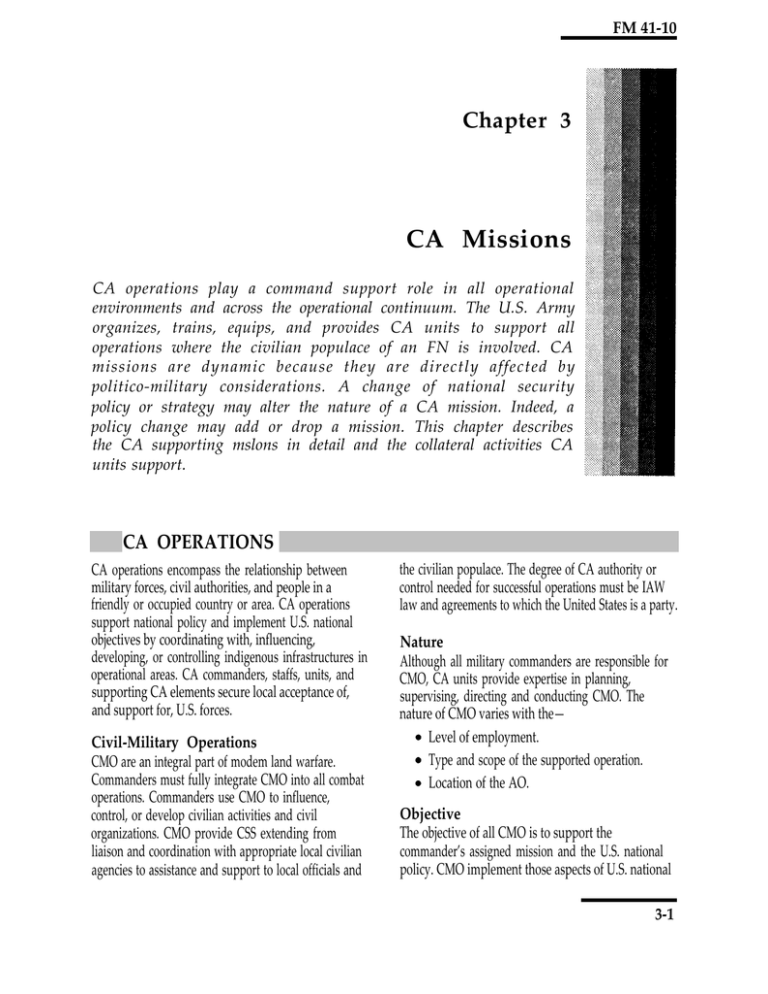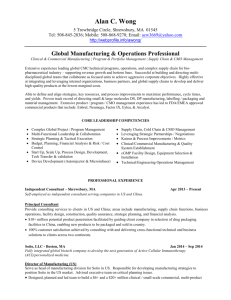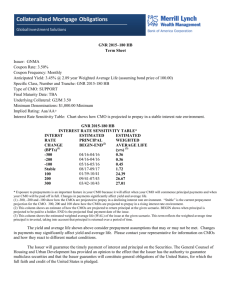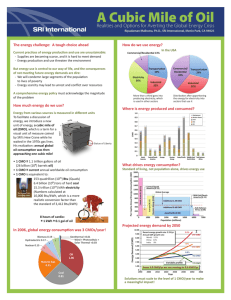CA Missions Chapter 3
advertisement

FM 41-10 Chapter 3 CA Missions CA operations play a command support role in all operational environments and across the operational continuum. The U.S. Army organizes, trains, equips, and provides CA units to support all operations where the civilian populace of an FN is involved. CA missions are dynamic because they are directly affected by politico-military considerations. A change of national security policy or strategy may alter the nature of a CA mission. Indeed, a policy change may add or drop a mission. This chapter describes the CA supporting mslons in detail and the collateral activities CA units support. CA OPERATIONS CA operations encompass the relationship between military forces, civil authorities, and people in a friendly or occupied country or area. CA operations support national policy and implement U.S. national objectives by coordinating with, influencing, developing, or controlling indigenous infrastructures in operational areas. CA commanders, staffs, units, and supporting CA elements secure local acceptance of, and support for, U.S. forces. Civil-Military Operations CMO are an integral part of modem land warfare. Commanders must fully integrate CMO into all combat operations. Commanders use CMO to influence, control, or develop civilian activities and civil organizations. CMO provide CSS extending from liaison and coordination with appropriate local civilian agencies to assistance and support to local officials and the civilian populace. The degree of CA authority or control needed for successful operations must be IAW law and agreements to which the United States is a party. Nature Although all military commanders are responsible for CMO, CA units provide expertise in planning, supervising, directing and conducting CMO. The nature of CMO varies with the— Level of employment. Type and scope of the supported operation. Location of the AO. Objective The objective of all CMO is to support the commander’s assigned mission and the U.S. national policy. CMO implement those aspects of U.S. national 3-1 FM 41-10 policy pertaining to a commander’s responsible area. Support may include operations in civil emergency situations resulting from natural disaster, unrest, or enemy attack. Support of the commander’s politico-military mission may involve participation in coordinated activities with other U. S., allied, or international military components or civil agencies. Mission Activities The focus of CMO is to support military objectives. Regardless of whether CMO objectives are strategic or operational, the fundamental CMO doctrine, tactics, and techniques remain unchanged. CMO include the following interrelated mission activities: FNS, PRC, HA, MCA, and civil defense. For more information, see Chapter 10. Foreign Nation Support The preferred means for closing the gap in CSS requirements is to secure goods and services locally. The term FNS includes both HNS and third country support. Depending on the support available, CA personnel identify resources and assist other staff agencies in their procurement (ad hoc requests). They also activate preplanned requests for wartime FNS. Populace and Resources Control CA personnel assist in planning and conducting PRC programs employed during most military operations. These programs consist of curfews, movement restrictions, resettlement of DCs, licensing, rations control, and inspection of facilities. DC operations and NEO are specialized PRC. Humanitarian Assistance HA is a group of programs that authorize the use of DOD resources to conduct military acts and operations of a humanitarian nature. HA includes H/CA, foreign disaster relief, NEO, and support to foreign displaced civilians (refugees and evacuees). Combatants, to include members of groups engaged in paramilitary activities, can receive assistance under some of these programs (for example, the DOD nonlethal property program). One program for noncombatants only is the H/CA program provided by the Stevens Authority (10 USC 401). This program provides limited authority to use 3-2 DOD operation and maintenance funding for approved H/CA activities incidental to authorized military operations in a foreign country. It defines H/CA projects as— Medical, dental, and veterinary care in rural areas. Construction of rudimentary surface transportation systems (no airfields). Well drilling and construction of basic sanitation facilities. Rudimentary construction and repair of public facilities. H/CA projects must promote the security interests of both the United States and foreign country involved. They must also enhance specific operational readiness skills of the participating U.S. service members. The projects cannot duplicate other U.S. government programs. Military Civic Action MCA projects result in populace support for the government’s programs. CA personnel conduct MCA to enhance the effectiveness, legitimacy, and image of the government and/or military. They must carefully evaluate the importance of the project in relation to its actual or potential value. They should work hand-in-hand with local personnel, in numbers small enough to show a U.S. presence, but not large enough to overwhelm. Local forces should receive the credit for the projects and take pride in their achievements, while U.S. personnel remain in the background, unless otherwise requested. The scope of MCA projects can be expanded to include military and paramilitary forces as benefactors of U.S. support in foreign countries. Civil Defense Civil defense deals with the immediate emergency conditions created by an attack or natural or manmade disasters. Examples of civil defense include emergency repairs and restoration of destroyed or damaged vital utilities and facilities. CA personnel determine the status of local civil defense planning and organization in their assigned area. The CA personnel coordinate planning for— Government. Industry. FM 41-10 Public utilities. Public health. Emergency situations. Legal Aspects of CMO U.S. law, including the laws of a state, territory, possession, or other political subdivision, governs the legal aspects of CMO. Provisions for a foreign state’s law may impact on CMO. In some cases, a bilateral or multilateral agreement, including an agreement concluded without the formalities required of treaties, governs CMO. A rule or law established by custom or by a rule of international law may also govern CMO. Civil Administration Support to civil administration ranges from assistance to friendly governments to providing civil administration in a U.S.-occupied territory. U.S. forces establish civil administration in friendly territory under an agreement with the local government. They exercise certain authority that is normally a government function. U.S. forces may also establish CMO in a U.S.-occupied territory. CMO continue until an indigenous civil government supporting U.S. and allied objectives can be established. The military role in civil administration varies with— NCA direction. The need or degree of support required by the allied government. The operational continuum. CA units provide government support capabilities. This support aids the transition from military (combat) objectives to political objectives. It also furthers U.S. policy by maintaining a stable and peaceful society under civilian government. Civil administration requires CA units with special government functional expertise. For more information, see Chapter 4. These CA assets can— Ensure the equitable distribution of humanitarian supplies and services. Provide advice and assistance to other U.S. military forces that temporarily assume functions normally performed by a civilian government. Accomplish efficient liaison and negotiations with other military, nonmilitary, foreign government, and USG agencies. Assist the U.S. military’s goal to establish a government that supports U.S. objectives and to return control to a duly recognized government as quickly as possible. The dynamic nature of civil administration can be defined by the following interrelated activities and the concurrent use of CMO: civil assistance, civil administration in friendly territory, and civil administration in occupied territory. For more information, see Chapter 11. Civil Assistance Civil assistance provides life-sustaining services, maintains order, or controls distribution of goods and services within a commander’s assigned AOR. Civil assistance differs from the other two forms of civil administration because it is based on the commander’s decision. Civil Administration in Friendly Territory Support to civil administration in friendly territory reinforces or restores a friendly government. When disaster or war disrupts political institutions and economic systems, and local authorities so request, the U.S. military can temporarily assume many of the functions normally performed by civilian government organizations. Civil Administration in Occupied Territory International laws and the laws and policies of the United States regulate U.S. civil administration. The occupying power, within its capabilities, must maintain an orderly government in the occupied territory. CA units with special government functional expertise support civil administration by developing an effective civil government in the occupied territory. For more information, see Chapter 4. 3-3 FM 41-10 SUPPORT REQUIREMENTS In addition to their two supporting missions, CA units support other SOF primary missions such as FID and UW. They also support the collateral activities of HA, nation assistance, SA, AT and other security activities, CD operations, and PKO (Figure 3-l). CA commanders should anticipate support requirements for these collateral activities and ensure their units prepare for them. Not all CA units have the same support requirements or priorities. Support requirements and priorities vary from theater to theater and from unit to unit within a theater. Foreign Internal Defense FID is the participation by civilian and military agencies of a government in any of the action programs taken by another government to free and protect its society from subversion, lawlessness, and insurgency. When supporting a FID mission, CA teams train, advise, and support U.S. SF units. They coordinate CA operations with other U.S. military forces and HN and USG agencies in the counterinsurgency effort. Still other CA teams may perform any or all of their wartime missions in hostile or politically sensitive territory. In a counterinsurgency environment, CA operations may occur within or outside the HN. The primary CA role in FID is to help HN forces mobilize the people and other resources in support of the HN government. CA support may range from staff advice and assistance to the commitment of CA units. Activities may include— Coordinating CA operations with appropriate HN, United States, and international agencies. Minimizing civilian interference with operations. Providing civil assistance to HN government agencies. 3-4 FM 41-10 Serving as the focal point for community relations. Advising and assisting other SOF conducting MCA or HA programs. Advising and assisting GP forces and other SOF in planning and implementing a civil defense program. Supplementing the intelligence collection effort. Supporting DC operations, to include advising or assisting the HN government in establishing and operating DC camps. In a limited or general war, CA units may support FID missions against armed resistance organizations opposing friendly conventional military operations. CA units may also support FID missions to counter insurgences in the strategic rear of the theater. Unconventional Warfare UW is a broad spectrum of military and paramilitary operations, normally of long duration. It is mainly conducted by indigenous or surrogate forces that an external source has organized, trained, equipped, supported, and directed in varying degrees. UW includes guerrilla warfare and other direct offensive, low visibility, covert, or clandestine operations. It also includes the indirect activities of subversion, sabotage, intelligence collection, and E&E. When supporting a UW mission, the supporting CA unit trains, advises, and assists deploying SF teams in CMO and supports civil administration at the end of hostilities. Humanitarian Assistance HA consists of programs designed to mitigate the results of natural or man-made disasters or other endemic conditions. Through HA programs, CA personnel help reduce human pain, disease, suffering, hunger, hardship, or privation. These conditions might present a serious threat to life or result in great damage to, or loss of, property. HA is usually limited in scope and duration. As stated earlier, combatants, to include paramilitary forces, can receive assistance under some HA programs. Nation Assistance Nation assistance describes the type of support provided to assist nations promote their own development and growth. The goal of nation assistance is— Long-term regional stability. Pluralistic governments. Sound democratic institutions. Viable economies. Means for orderly change. CMO should be a component of a preventive strategy to correct HN ills before lawlessness, subversion, or insurgency becomes a serious problem. CA units, because of their missions and force structure, have unique capabilities to coordinate nation assistance and supporting activities. One of the keys to a successful nation assistance program is to use the technical skills and resources of the CA community. CA units use these skills to integrate and coordinate the HN’s efforts. Emphasis is on developing HN capabilities in key areas by transferring skills to the civilian and military sector. This focus supports legitimacy of the HN government and U.S. military operations. Security Assistance SA is a group of programs authorized by the Foreign Assistance Act, the Arms Export Control Act, or other related U.S. statutes. The USG provides defense articles and services, including training, to eligible foreign countries and international organizations that further U.S. national security objectives. The primary CA role in SA is to provide specialists to accompany SF MTTs and other forms of mobile training assistance. Public law prohibits personnel providing SA services (to include mobile training assistance) from performing combatant duties. See DOD 5105-38-M and ARs 12-1 and 12-15 for detailed discussions on SA programs. Antiterrorism and Other Security Activities AT and other security activities ensure the physical security of important persons, facilities, and events meets acceptable standards. Responding to requests from other government agencies, CA personnel can 3-5 FM 41-10 provide training and advice on how to reduce vulnerability to terrorism and other hostile threats. CA units use their public safety expertise to foresee hostile activity and evaluate the adequacy of existing physical security systems. For more information, see Chapter 13. Counterdrug Operations CD operations are measures taken to disrupt, interdict, and destroy illicit drug activities. The levels of violence used by the drug infrastructure dictate the increased use of military and paramilitary forces in CD operations. A 1981 amendment to the Posse Comitatus (18 U.S. Code 1385) authorizes specific DOD assistance in drug interdiction. The primary CA role in this interagency activity is to support U.S. and HN CD efforts abroad. The DOS’s Bureau of International Narcotics Matters and the DOJ’s DEA are normally the lead U.S. operational CD agencies within a HN. When these agencies or the HN requests military assistance, CA teams may provide in-country or out-of-country (offshore) training to U.S. and HN CD forces. CA advisors may also assist the CD staffs in planning, organizing, and conducting long-term CD operations. When authorized, and subject to legal and policy constraints, CA advisors may also accompany CD forces on actual operations. The United States may participate in PKO— Under the auspices of an international organization. In cooperation with the countries. Unilaterally. Figure 3-3 depicts CA activities and CMO conducted during PKO. CMO will be based on the provisions of the CA agreement and SOFAS between all parties. 3-6 Peacekeeping Operations PKO support diplomatic efforts to achieve, restore, or maintain the peace in areas of potential or actual conflict. Such operations take place only after the conflict is in abeyance. PKO may take many forms (Figure 3-2). FM 41-10 JOINT OPERATIONS CA units can support and enhance joint operations with other services. U.S. joint military policies and doctrine and specific theater military policies, strategies, and doctrine provide the framework for the application of CA doctrine. Joint forces include unified and specified commands and JTFs. A unified command consists of forces from two or more services. These forces operate under the OPCOM of a single unified CINC responsible for a specific geographic area. The CINC normally exercises OPCOM at a predetermined location during the employment of a unit. A specified command is primarily a single service command, though it may have elements of other services. A specified command receives strategic direction from the JCS. A JTF normally draws units from the USSOCOM and performs missions having specific, limited objectives or missions of short duration. It dissolves when it has achieved its purpose. The JTF commander has OPCON over the entire force. He exercises logistical coordination or control for CA units only as necessary to meet their logistical needs. Joint commanders have the authority necessary for mission accomplishment. OPCOM and OPCON are terms used to describe the authority exercised by joint commanders over subordinate components. Both OPCOM and OPCON empower joint commanders to— Assign tasks. Establish composition of subordinate forces. Designate objectives. Direct actions. COMBINED OPERATIONS CA units support and enhance combined operations. They provide a link between U.S. military and the military forces and civilian agencies of other nations. In combined theaters, the allies share a compelling need to maintain the political cohesion of the coalition as a prerequisite for maintaining their military effectiveness. Accommodating differences in politico-military objectives is therefore highly important, Accommodating differences in capabilities among allied military forces requires careful planning and tailored coordination and liaison between forces. The exchange of liaison parties with reliable communications is required when an operation depends on close cooperation between allied units. CA units can assist in controlling operations that require the cooperation of HN civilian authorities. Combined commanders must resolve the problems of liaison, language, and compatibility of equipment inherent in multinational military operations. They may use HNS to add or substitute U.S. services, supplies, and facilities. Water, food, and construction materials may have to be obtained by a central allied agency and shared equally among the national contingents. CA units are well suited to meet the challenges of coalition warfare because of their unique strategic capabilities. CONTINGENCY OPERATIONS Contingency operations are military actions requiring rapid deployment to perform military tasks in support of national policy. Such operations are normally pursued when vital national interests are at stake and diplomacy and other forms of influence are ineffective. Either a show of force or direct military action then becomes necessary. Contingency operations are joint undertakings conducted within the framework of the unified command system. CA planners enhance contingency operations by— Informing civilian authorities of the risks associated with proposed plans. Providing the best available information, including political, social, and economic considerations. 3-7 FM 41-10 Identifying additional resources that would effectively reduce risk. Identifying the political situation and civil-military responsibilities. Identifying language requirements, in-country facilities, and local resources. MULTIPLE AND FOLLOW-ON MISSIONS Actual operational requirements often cut across doctrinal mission lines. A CA team may conduct an operation involving multiple missions. It may also receive a follow-on mission after its initial mission. Multiple missions are appropriate when operational requirements demand the application of TTP drawn from more than one doctrinal mission. For example, a CA team maybe training, assisting, and directing indigenous police operations (civil administration mission) within the supported commander’s assigned area and coordinating DC operations (CMO mission) to minimize civilian interference with military operations. In a UW environment, a CA team may be coordinating HA activities (CMO mission) and assisting in the 3-8 transition of power during linkup of resistance forces and U.S.-supported government agencies (civil administration mission). Follow-on missions are appropriate when the transition from military control to civilian control is required in fulfilling political objectives. A CA team may assist an existing government in providing life-sustaining services, maintaining order, and controlling the distribution of goods and services within a commander’s AOR (civil administration mission). And once the situation stabilizes, the CA team may conduct activities that enhance the effectiveness, legitimacy, and image of the existing government (CMO mission).






